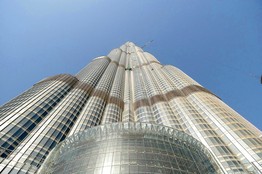DUBAI — Amid a slumping real-estate market and canceled or delayed development projects across this city-state, a mystery is swirling over the nearly completed Burj Dubai, already the world’s tallest skyscraper: When will it open?
 Emaar Properties PJSC, the Middle East’s largest home builder by market capitalization, isn’t saying.
Emaar Properties PJSC, the Middle East’s largest home builder by market capitalization, isn’t saying.
Emaar Chairman Mohamed Ali Alabbar last year said that September 2009 was a “possible and reasonable” date for completion.
However, this date slipped after the company said it wasn’t happy with the interior design and wanted to upgrade it. Local media reports now suggest the United Arab Emirates National Day on Dec. 2 as the new deadline, but Emaar has refused to confirm, saying only that it will open “this year.”
A handful of cranes still are working halfway up the tower, which stands at just over 2,625 feet. Emaar won’t disclose the tower’s final height until completion, although most estimates put it at 2,684 feet, far taller than Taiwan’s Taipei 101, which had been the world’s tallest skyscraper at 1,670 feet.
Emaar’s silence on the issue, and the emirate’s financial woes, has intensified the mystery surrounding the $1 billion tower and sparked questions around the city about the readiness of the building. It also has raised concerns among investors who have paid as much as $3.5 million for one-bedroom apartments there.
The Burj Dubai, or Dubai Tower, was intended as a symbol of the city-state’s global ambition and engineering capabilities, but the emirate’s real-estate and financial landscape has changed since construction of the tower started in September 2004.
Like other places around the world, Dubai has been hit by a property slump as a result of the global credit crunch. Home values have fallen by about half from their peak in the third quarter of last year. As the downturn shows no signs of letting up, many developers are being forced to scale back real-estate projects, shed staff and make other cash-saving moves.
Emaar, which dominated the Dubai building boom since it opened up to foreign investors in 2002, also is facing the impact of falling house prices and sales both at home and overseas. In July, it posted a second-quarter loss of $350 million, compared with a net profit of $571 million a year earlier after it was forced to write off $470 million from its U.S.-based John Laing Homes division. The developer said it is putting expansion plans on hold and is focusing on finishing existing projects to offset the downturn.
The opening of the Burj Dubai, which stands at the heart of Emaar’s $20 billion flagship Downtown development close to Dubai’s main business district, won’t only lift Emaar’s reputation globally, it also will boost the developer’s revenue by almost $1 billion as residential units are delivered to owners. Most buyers are expected to close on apartments because they already have paid most of the sales price.
The tower’s design by Adrian Smith, an architect at Chicago-based Skidmore, Owings & Merrill LLP until 2006, is drawn from the desert flower, hymenocalis. Skidmore continues to be in charge of the project, with Samsung Engineering & Construction and Belgium’s Besix SA as its primary builders.
When finished, the skyscraper will have an estimated population of 35,000 over 160 floors, 54 elevators, almost a thousand residential units and more than 220,000 square feet of prime business space.
It also will house Italian fashion designer Giorgio Armani’s first hotel with 160 guest rooms, four swimming pools, a cigar club, a library, spas and an observation platform on the 124th floor.
Emaar launched the first phase of sales of the 144 one- and two-bedroom Armani Residences apartments in October 2007, and they sold out. The building also has 900 other condominiums.
At the height of Dubai’s property boom, one-bedroom apartments were selling for between $1,715 and $2,776 a square foot on the secondary market, according to Betterhomes, one of Dubai’s largest real-estate brokers.
One of the most expensive apartments on its books at the time was a one-bedroom apartment that sold for just over $3.5 million.
Today, prices have slumped between 50% and 60% and sales on the secondary market have stalled due to a wide gap between asking and offered prices. Few of the Burj apartments are listed on the secondary market.
The Burj Dubai became the world’s tallest building in July 2007. In April 2008, it became the tallest man-made structure, exceeding the KVLY-TV mast in North Dakota, which stands 2,063 feet.
It isn’t clear how long the Burj Dubai will hold the title of world’s tallest. Plans for taller towers have been announced around the world.
Last year, Dubai government-owned developer Nakheel, which is building the emirate’s iconic palm-tree-shaped archipelagos, said it planned to build a 3,274-foot tower in Dubai as part of a $38 billion commercial and residential project. The company has since delayed the project.
Write to Stefania Bianchi at stefania.bianchi@dowjones.com












